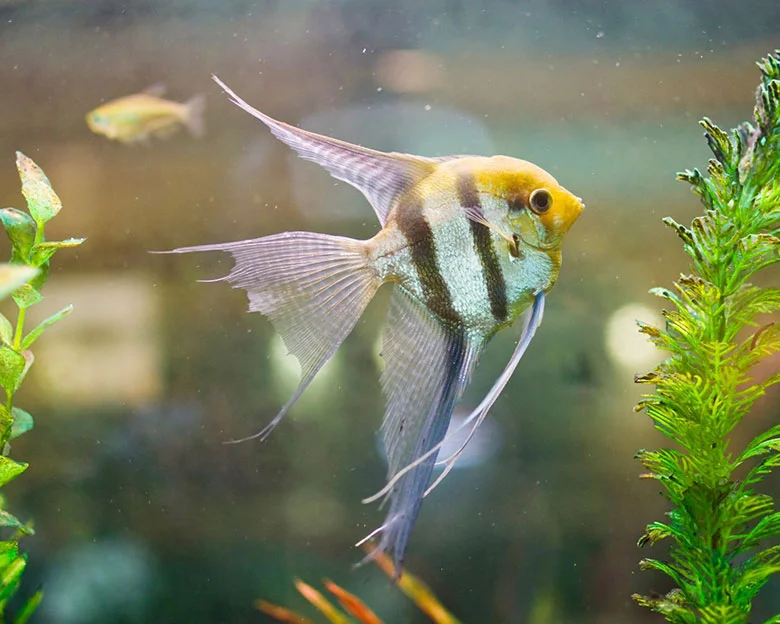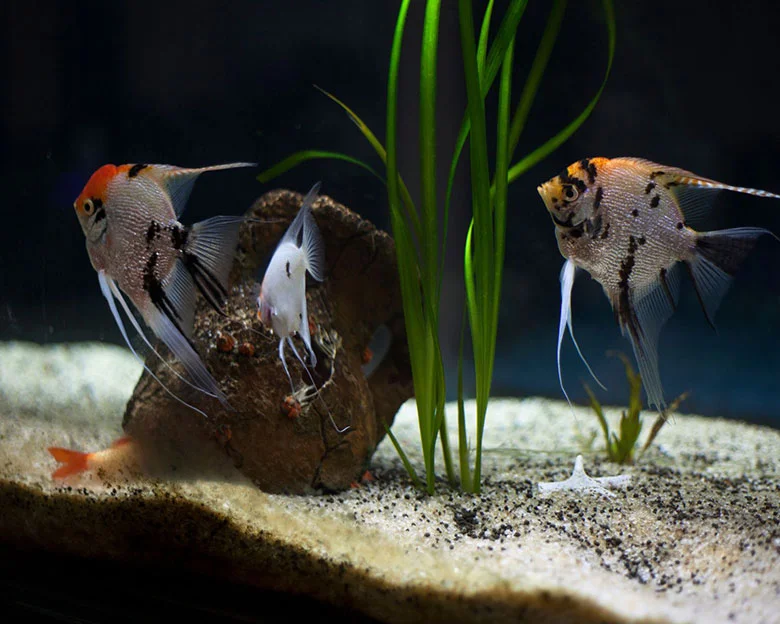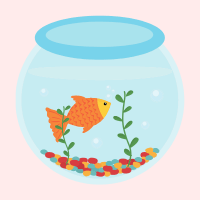Did you know that providing the optimal diet for your angelfish can greatly enhance their health and vibrant colors? In fact, studies have shown that a well-balanced diet can improve the overall well-being of angelfish by promoting growth, boosting immune function, and enhancing their natural colors.
Welcome to the angelfish feeding guide, where we will explore the key components of an ideal diet for these fascinating creatures. As omnivores, angelfish require a variety of foods to thrive, including flakes, pellets, live food, frozen food, vegetables, and brine shrimp.
By offering a diverse range of options, you can ensure that your angelfish receive the essential nutrients they need for optimal health.
In this article, we will delve into the different types of food suitable for angelfish, discuss the feeding schedule that best suits their needs, and provide valuable tips on tank maintenance to support their well-being.
Whether you are a seasoned angelfish owner or just starting out, this comprehensive guide will equip you with the knowledge to provide your angelfish with a diet that promotes their vibrant health and longevity.
Key Takeaways
- Angelfish are omnivorous and eat both plant and animal matter.
- They can be fed flakes, pellets, live food, frozen food, vegetables, and brine shrimp.
- Feeding a variety of foods is important for the angelfish’s health and coloration.
- Regular tank maintenance, including water changes and gravel vacuuming, is necessary for the angelfish’s health.
What Do Angelfish Eat?

You can feed your angelfish a variety of foods such as flakes, pellets, live food, frozen food, vegetables, and brine shrimp to ensure they have a balanced and nutritious diet. Providing a varied diet is important for the vibrant health of your angelfish.
A varied diet offers several benefits, including improved growth, coloration, and overall well-being. It’s essential to consult experts for accurate feeding information, as they can guide you on the specific dietary requirements of your angelfish. They can provide valuable insights on the appropriate portion sizes and feeding schedule for your fish.
By seeking expert advice, you can ensure that your angelfish receives the optimal nutrition it needs to thrive in your aquarium.
Types of Food
Surprisingly, there are a multitude of food options available for your finned friends. Providing a varied diet is essential for the vibrant health of your angelfish. It’s important to consult experts for feeding advice to ensure you’re meeting their nutritional needs.
A varied diet offers numerous benefits, including improved coloration and overall health. Experts recommend incorporating the following food options into your angelfish’s diet:
- Flakes and Pellets: These nutritionally dense options are rich in fatty acids and provide essential nutrients for growth and health.
- Live and Frozen Foods: Worms, insect larvae, and crustaceans are excellent supplements for angelfish. Frozen options such as bloodworms, brine shrimp, and daphnia are convenient and nutritious.
- Vegetables: Cucumber, zucchini, broccoli, and kale are great sources of vitamins and minerals for your angelfish.
Remember, a healthy diet is crucial for the well-being of your angelfish. By researching and finding the best food products, you can provide your finned friends with optimal nutrition and vibrant health.
Feeding Schedule
Establishing a regular feeding schedule for your angelfish is essential for their overall well-being. The angelfish feeding guide suggests that feeding frequency and techniques play a crucial role in maintaining vibrant health in your angelfish. If you need a feeding guide on Pleco, check out our latest guide. It is recommended to feed your angelfish manageable portions twice a day, ensuring they can consume the food within two minutes to prevent overfeeding.
An automatic fish feeder can be a helpful tool in maintaining a regular feeding schedule, especially if you have a busy lifestyle. Additionally, it is important to vary their diet to provide a balanced nutritional intake.
To help you visualize a feeding schedule for your angelfish, here is a table outlining a sample plan:
| Time of Day | Feedings |
|---|---|
| Morning | Flake food, pellets, or freeze-dried bloodworms |
| Afternoon | Live food, such as brine shrimp or blackworms |
| Evening | Vegetables, such as cucumber or zucchini |
Remember to always research and consult experts for accurate feeding information to ensure the best diet for your angelfish.
Tank Maintenance
Regular maintenance of your tank is crucial for ensuring the well-being of your angelfish. Here are the benefits of regular water changes in angelfish tanks:
- Removal of toxins and waste: Water changes help eliminate harmful substances like ammonia and nitrates, maintaining a healthy environment for your angelfish.
- Improved water quality: By replacing old water with fresh, clean water, you provide your angelfish with optimal conditions for growth and overall health.
- Prevention of diseases: Regular water changes reduce the risk of bacterial and fungal infections, keeping your angelfish safe and disease-free.
- Enhanced coloration and vitality: Fresh water promotes vibrant coloration in angelfish, making them even more beautiful to admire.
In addition to water changes, gravel vacuuming is equally important for angelfish tank maintenance. This process helps remove debris and uneaten food from the substrate, preventing the accumulation of harmful substances and ensuring a clean and healthy environment for your angelfish.

Frequently Asked Questions
How Often Should I Feed My Angelfish?
To ensure optimal growth and health for your angelfish, it’s important to feed them with the best techniques. The key is to provide a balanced diet that includes a variety of foods.
Feed your angelfish manageable portions twice a day, ensuring they can consume it within two minutes to prevent overfeeding. Incorporate high-protein options like frozen brine shrimp and small pellets for juveniles, and varied options including freeze-dried foods, flakes, live food, and vegetables for adults.
A balanced diet is crucial for vibrant health in angelfish.
Can Angelfish Eat Fruits?
Fruits can provide nutritional benefits for angelfish, enhancing their overall health. Some of the best fruits to include in an angelfish’s diet are bananas, oranges, and apples. These fruits are rich in vitamins and minerals that can support the angelfish’s immune system and promote vibrant coloration.
Bananas offer potassium, oranges provide vitamin C, and apples offer a range of vitamins and antioxidants. Incorporating these fruits into their diet can contribute to the well-being of your angelfish.
Are There Any Specific Foods I Should Avoid Feeding My Angelfish?
To ensure the optimal health of your angelfish, it’s important to avoid feeding them certain foods that can pose potential health risks. Some foods to avoid include high-fat and processed human foods, as well as foods that are difficult for angelfish to digest, such as large chunks of meat or hard vegetables.
Additionally, avoid feeding your angelfish foods that are known to cause digestive issues, such as peas and spinach. Feeding a proper diet is crucial to prevent health problems and maintain the vibrant health of your angelfish.
Can Angelfish Eat Algae?
Angelfish have a remarkable symbiotic relationship with algae, which can benefit their diet in various ways. Algae provides essential nutrients, such as vitamins and minerals, that contribute to the overall health of angelfish. Additionally, the fiber content in algae aids in digestion and prevents constipation.
The algae-angelfish symbiosis also helps maintain water quality by reducing ammonia and nitrate levels. Including algae in an angelfish’s diet is highly recommended for their vibrant health and overall well-being.
How Can I Prevent Overfeeding My Angelfish?
To prevent overfeeding your angelfish, it’s important to create a feeding schedule. Feed them manageable portions twice a day, ensuring they can consume all the food within two minutes. This will prevent excess food from polluting the water and causing health issues.
Common signs of overfeeding include uneaten food sinking to the bottom, cloudy water, and obesity in the fish. By following a feeding schedule and observing your angelfish’s behavior, you can ensure they receive the right amount of food for their optimal health.

